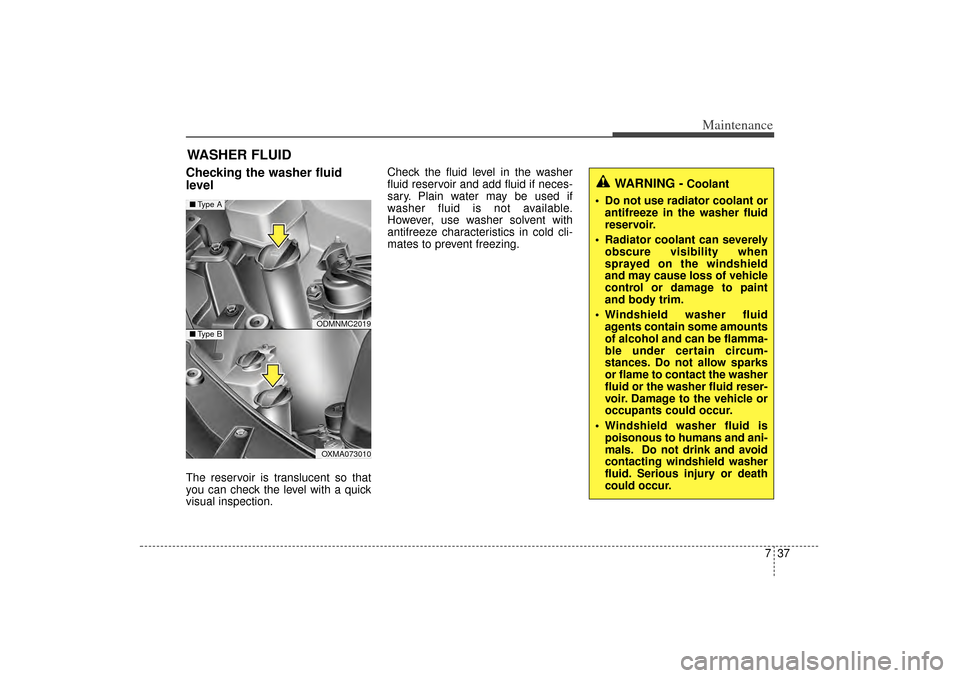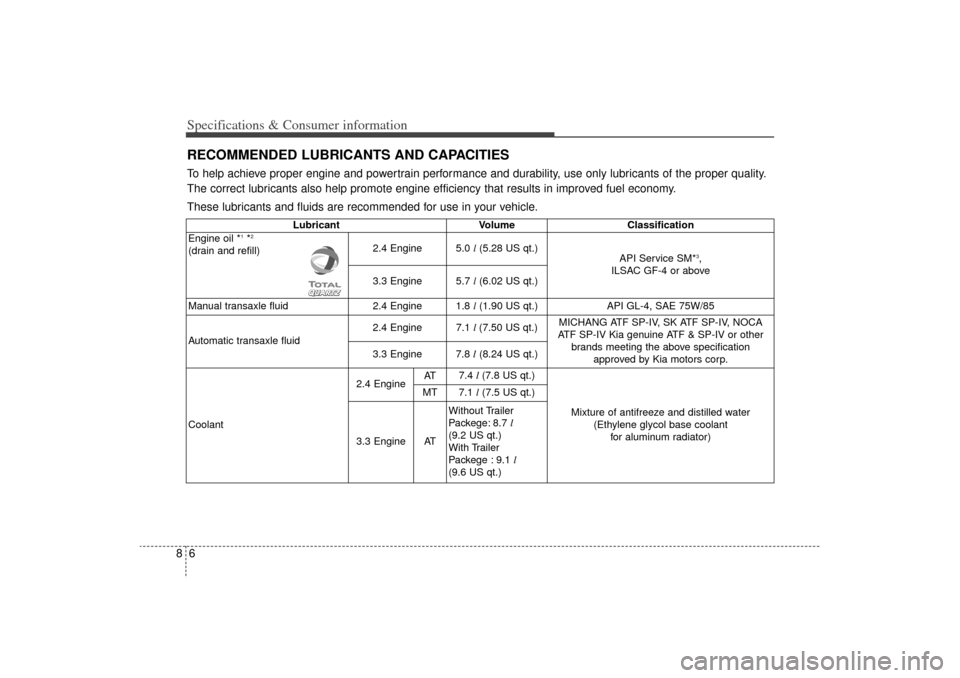2014 KIA Sorento coolant
[x] Cancel search: coolantPage 441 of 508

737
Maintenance
WASHER FLUIDChecking the washer fluid
levelThe reservoir is translucent so that
you can check the level with a quick
visual inspection.Check the fluid level in the washer
fluid reservoir and add fluid if neces-
sary. Plain water may be used if
washer fluid is not available.
However, use washer solvent with
antifreeze characteristics in cold cli-
mates to prevent freezing.
WARNING -
Coolant
Do not use radiator coolant or antifreeze in the washer fluid
reservoir.
Radiator coolant can severely obscure visibility when
sprayed on the windshield
and may cause loss of vehicle
control or damage to paint
and body trim.
Windshield washer fluid agents contain some amounts
of alcohol and can be flamma-
ble under certain circum-
stances. Do not allow sparks
or flame to contact the washer
fluid or the washer fluid reser-
voir. Damage to the vehicle or
occupants could occur.
Windshield washer fluid is poisonous to humans and ani-
mals. Do not drink and avoid
contacting windshield washer
fluid. Serious injury or death
could occur.
ODMNMC2019OXMA073010
■ Type A■Type B
XM(FL) CAN(ENG) 7.QXP 1/23/2013 3:36 PM Page 37
Page 464 of 508

Maintenance60
7Tire terminology and definitions
Air Pressure: The amount of air
inside the tire pressing outward on
the tire. Air pressure is expressed in
kilopascal (kPa) or pounds per
square inch (psi).
Accessory Weight : This means the
combined weight of optional acces-
sories. Some examples of optional
accessories are, automatic
transaxle, power seats, and air con-
ditioning.
Aspect Ratio: The relationship of a
tire's height to its width.
Belt: A rubber coated layer of cords
that is located between the plies and
the tread. Cords may be made from
steel or other reinforcing materials.
Bead: The tire bead contains steel
wires wrapped by steel cords that
hold the tire onto the rim.
Bias Ply Tire : A pneumatic tire in
which the plies are laid at alternate
angles less than 90 degrees to the
centerline of the tread. Cold Tire Pressure: The amount of
air pressure in a tire, measured in
kilopascals (kPa) or pounds per
square inch (psi) before a tire has
built up heat from driving.
Curb Weight: This means the weight
of a motor vehicle with standard and
optional equipment including the
maximum capacity of fuel, oil and
coolant, but without passengers and
cargo.
DOT Markings: The DOT code
includes the Tire Identification
Number (TIN), an alphanumeric des-
ignator which can also identify the
tire manufacturer, production plant,
brand and date of production.
GVWR: Gross Vehicle Weight Rating
GAWR FRT: Gross Axle Weight
Rating for the Front Axle.
GAWR RR: Gross Axle Weight
Rating for the Rear axle.
Intended Outboard Sidewall
: The
side of an asymmetrical tire, that
must always face outward when
mounted on a vehicle.
Kilopascal (kPa): The metric unit for
air pressure.
Load Index: An assigned number
ranging from 1 to 279 that corre-
sponds to the load carrying capacity
of a tire.
Maximum Inflation Pressure: The
maximum air pressure to which a
cold tire may be inflated. The maxi-
mum air pressure is molded onto the
sidewall.
Maximum Load Rating : The load
rating for a tire at the maximum per-
missible inflation pressure for that
tire.
Maximum Loaded Vehicle Weight :
The sum of curb weight; accessory
weight; vehicle capacity weight; and
production options weight.
Normal Occupant Weight: The
number of occupants a vehicle is
designed to seat multiplied by 68 kg
(150 pounds).
XM(FL) CAN(ENG) 7.QXP 1/23/2013 3:37 PM Page 60
Page 486 of 508

Maintenance82
7CanisterFuel vapors generated inside the fuel
tank are absorbed and stored in the
onboard canister. When the engine is
running, the fuel vapors absorbed in
the canister are drawn into the surge
tank through the purge control sole-
noid valve.Purge Control Solenoid Valve
(PCSV)The purge control solenoid valve is
controlled by the Engine Control
Module (ECM); when the engine
coolant temperature is low during
idling, the PCSV closes so that evap-
orated fuel is not taken into the
engine. After the engine warms up
during ordinary driving, the PCSV
opens to introduce evaporated fuel to
the engine.
3. Exhaust emission control
systemThe Exhaust Emission Control
System is a highly effective system
which controls exhaust emissions
while maintaining good vehicle per-
formance.Vehicle modifications This vehicle should not be modified.
Modification of your vehicle could
affect its performance, safety or
durability and may even violate gov-
ernmental safety and emissions reg-
ulations.
In addition, damage or performance
problems resulting from any modifi-
cation may not be covered under
warranty.
If you use unauthorized electronic
devices, it may cause the vehicle to
operate abnormally, wire damage,
battery discharge and fire. For your
safety, do not use unauthorized
electronic devices.
Engine exhaust gas precautions
(carbon monoxide) Carbon monoxide can be present with other exhaust fumes.
Therefore, if you smell exhaust
fumes of any kind inside your vehi-
cle, have it inspected and repaired
immediately. If you ever suspect
exhaust fumes are coming into
your vehicle, drive it only with all
the windows fully open. Have your
vehicle checked and repaired
immediately.
WARNING -
Exhaust
Engine exhaust gases contain
carbon monoxide (CO). Though
colorless and odorless, it is
dangerous and could be lethal if
inhaled. Follow the instructions
on this page to avoid CO poi-
soning.
XM(FL) CAN(ENG) 7.QXP 1/23/2013 3:38 PM Page 82
Page 494 of 508

Specifications & Consumer information68RECOMMENDED LUBRICANTS AND CAPACITIES To help achieve proper engine and powertrain performance and durability, use only lubricants of the proper quality.
The correct lubricants also help promote engine efficiency that results in improved fuel economy.
These lubricants and fluids are recommended for use in your vehicle.
LubricantVolume Classification
Engine oil *
1*2
(drain and refill) 2.4 Engine
5.0
l(5.28 US qt.)
API Service SM*
3,
ILSAC GF-4 or above
3.3 Engine 5.7
l(6.02 US qt.)
Manual transaxle fluid 2.4 Engine 1.8
l(1.90 US qt.)
API GL-4, SAE 75W/85
Automatic transaxle fluid 2.4 Engine
7.1
l (7.50 US qt.) MICHANG ATF SP-IV, SK ATF SP-IV, NOCA
ATF SP-IV Kia genuine ATF & SP-IV or other brands meeting the above specification approved by Kia motors corp.
3.3 Engine
7.8
l(8.24 US qt.)
Coolant 2.4 Engine
AT
7.4
l (7.8 US qt.)
Mixture of antifreeze and distilled water(Ethylene glycol base coolant for aluminum radiator)
MT
7.1 l(7.5 US qt.)
3.3 Engine AT Without Trailer
Packege: 8.7
l
(9.2 US qt.)
With Trailer
Packege : 9.1 l
(9.6 US qt.)
XM(FL) CAN(ENG) 8.QXP 1/23/2013 4:01 PM Page 6
Page 501 of 508

I3
Index
Parking brake ..........................................................5-32
Anti-lock brake system (ABS) ..................................5-34
Electronic stability control (ESC) ............................5-36
Vehicle stability management ..................................5-40
Hill-start assist control (HAC) ..................................5-41
Brakes/clutch fluid ........................................................7-36
Bulb wattage ....................................................................8-3
Camera (Rear view) ....................................................4-106
Capacities (Lubricants) ....................................................8-6
Care ........................................................................\
........7-50 Tire care ....................................................................7-50\
Exterior care ..............................................................7-74
Interior care ..............................................................7-79
Center console storage ................................................4-146
Central door lock switch................................................4-23
Checking the parking brake ..........................................7-38
Checking tire inflation pressure ....................................7-51
Child restraint system ....................................................3-38 Seat belt ....................................................................3-40\
Tether anchor system ................................................3-43
Child-protector rear door lock ......................................4-24
Climate control air filter ................................................7-41
Clock ........................................................................\
....4-154
Clothes hanger ............................................................4-155
Combined instrument, see instrument cluster ..............4-68 Compact spare tire ........................................................6-15
Compact spare tire replacement ....................................7-55
Coolant ........................................................................\
..7-33
Cooling fluid, see engine coolant ..................................7-33
Crankcase emission control system ..............................7-81
Cruise control system ....................................................5-44
Cruise control switch ................................................5-45
To set cruise control speed........................................5-45
Cup holder ..................................................................4-149
Curtain air bag ..............................................................3-67
Dashboard illumination, see instrument panel illumination ................................................................4-69
Dashboard, see instrument cluster ................................4-68
Day/night rearview mirror ............................................4-55
Daytime running light..................................................4-109
Defogging (Windshield) ..............................................4-142
Defogging logic ..........................................................4-144
Defroster (Rear window) ............................................4-120
Defrosting (Windshield) ..............................................4-142
Dimensions ......................................................................8-\
2
Display illumination, see instrument panel illumination ................................................................4-69
Displays, see instrument cluster ....................................4-68
Do not install a child restraint on the front passenger’s seat ................................................3-50C
D
XM(FL) CAN(ENG) Index.qxp 1/23/2013 3:41 PM Page 3
Page 502 of 508

Index4IDoor locks......................................................................4-\
21Central door lock switch ..........................................4-23
Child-protector rear door lock ..................................4-24
Drinks holders, see cup holders ..................................4-149
Driver position memory system ......................................3-8 Storing positions..........................................................3-9
Recalling positions ......................................................3-9
Easy access function ................................................3-10
Driver's and passenger's front air bag............................3-60
Driving at night..............................................................5-60
Driving in flooded areas ................................................5-61
Driving in the rain ........................................................5-60
Driving off-road ............................................................5-61
DRL see Daytime running light ..................................4-109
Economical operation ....................................................5-55
Electric chromic mirror (ECM) ....................................4-56
Electric power steering ..................................................4-49
Electronic stability control (ESC) ................................5-36
Emergency starting ..........................................................6-5 Jump starting ..............................................................6-5 Emission control system ................................................7-81
Crankcase emission control system ..........................7-81
Evaporative emission control System ......................7-81
Exhaust emission control system ..............................7-82
Engine ........................................................................\
......8-2
Engine compartment ........................................................2-6
Engine coolant ..............................................................7-33
Engine Coolant Temperature guage ..............................4-72
Engine number ..............................................................8-10
Engine oil ......................................................................7-\
31
Engine overheats..............................................................6-7
Engine start/stop button ..................................................5-8 Engine start/stop button position ................................5-8
Engine start/stop button position ....................................5-8
Engine will not start ........................................................6-4
Evaporative emission control System ..........................7-81
Exhaust emission control system ..................................7-82
Explanation of scheduled maintenance items ..............7-27
Exterior care ..................................................................7-74
Exterior overview (Front) ................................................2-2
Exterior overview (Rear) ................................................2-3E
XM(FL) CAN(ENG) Index.qxp 1/23/2013 3:41 PM Page 4